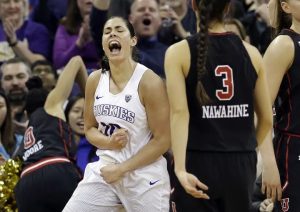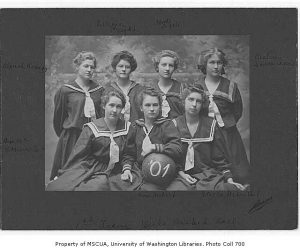Women and the Future of Collegiate Basketball
Molly Cheng, Jessica Swanson, Nicole Campbell, & Kaitlin De Boldt

The Player’s Perspective
The surge of popularity within collegiate women’s basketball was explored further in a conversation with a former women’s basketball player at Seattle University, Helen Sauvage, who saw attendance grow tremendously at both home and away games during her time at SU. Sauvage attributes this increase in attendance to the growing following of certain women’s basketball players on social media, such as Angel Reese, Caitlin Clark, and Washington native Hailey Van Lith, who currently have a collective instagram following of 6.5 million; as these women gained national recognition for their talents, more people started paying attention to women’s basketball in general. At the University of Washington, this is illustrated by a stark increase in attendance, with total attendance increasing from 18,843 in 2021 to 44,560 in 2023 1, as seen in the bar chart below. Undeniably, collegiate women’s basketball has grown tremendously, and Sauvage believes that the sky’s the limit for current and future collegiate players.
The study conducted by Steve Chen looked at how much attention men’s and women’s basketball teams get in the Southeastern Conference (SEC). They found that even though things have gotten better since a law called Title IX, which makes sure women and men have equal chances to play sports, there’s still a difference in how much the teams are talked about. While official athletic websites demonstrated a degree of parity, social media platforms such as Facebook and Twitter showed a notable divergence, with a greater emphasis on women’s teams. This observation aligns with insights shared by a men’s basketball player who had attended women’s basketball practice before mentioning that ‘Women’s basketball is growing; they are getting more media coverage.’ This highlights the transformative potential of social media in reshaping perceptions and fostering broader engagement with female athletics.

From then to Now
Women’s basketball has undergone a tremendous transformation since its inception in 1892, from wearing skirts with incredibly limited mobility to selling out stadiums during this year’s NCAA Women’s College Basketball tournament, a lot has changed. The rules from 1892 to 1970 that women had to play by would be unrecognizable today since the sport was seen as unladylike and therefore it had to be 6 v 6 with defense on one side of the court and offense on the other. Advancements in training techniques and coaching methods have significantly contributed to the development of players and the overall enhancement of their skills and athleticism, yet the media still only televises a fraction of their games in comparison to the number of men’s games. Sue Bird, a former Seattle Storm player believes that “We’re going to have a moment. It’s coming: just that breakthrough that’s going to give us a cool factor, and more people will want to be a part of it. Because that, to me, is the only thing we’re lacking – that social thing: ‘It’s cool to go to a WNBA game.’” It has been said for years that women’s basketball “isn’t as fun to watch” but in reality people just need to give it a chance, and when they do they will see how incredible these players are and the immense talent they possess.
The Place of Women’s Basketball at The University of Washington
Comparable to other major universities, Football and Men’s Basketball are the biggest revenue generating and popular sports at UW. These teams bring in a lot of media attention and thus are more popular than other sports. Fans of women’s sports recognize this disparity within the men’s and women’s college programs and as expressed by Sarah a UW student and supporter of women’s Basketball, “I hope that the college game can become more popular, and schools can put the same attention on it as they do the men’s, and eventually going to women’s games becomes a natural part of the going to college experience, as it is to go to a men’s Football or Basketball game.” This highlights the desire for more attention and commitment to women’s basketball not just from the universities, but from fans and the media as well.
Attending Football and Men’s Basketball games is often a crucial part of the going to college experience. These sports are an embodiment of “Thick Institutions”. As Brooks (2017) states, “A thick institution becomes a part of a persons identity and engages the whole person: head, hands, heart and soul”. They are a place where students form community and connect with one another on a social level outside of the classroom. These teams attract a lot of fans and there are often many traditions are rituals that students partake in when attending these games. These traditions and rituals are unique to the school and help connect students to their classmates but also to the university.
We opted out of AI tools for research, writing, or editing. Our story ideas are our own.
References
1 University of Washington. Washington Huskies. (n.d.). https://gohuskies.com/sports/womens-basketball/stats/2023-24
2 Chen, Steve Shih-Chia, et al. “Differences in Official Athletic Website Coverage and Social Media Use between Men’s and Women’s Basketball Teams.” The Sport Journal, 22 July 2016, thesportjournal.org/article/differences-in-official-athletic-website-coverage-and-social-media-use-between-mens-and-womens-basketball-teams/
3 Jenkins, Sally. “History of Women’s Basketball.” WNBA.Com, www.wnba.com/archive/wnba/about_us/jenkins_feature.html#:~:text=Women’s%20basketball%20has%20come%20a,frustrating%2C%20most%20of%20it%20fascinating. Accessed 16 May 2024.
4Brooks, D. (2017, April 18). How to leave a mark on people. The New York Times. https://www.nytimes.com/2017/04/18/opinion/how-to-leave-a-mark-on-people.html?mcubz=0
5Toma, J. D. (1999). The collegiate ideal and the tools of External Relations: The uses of high‐profile intercollegiate athletics. New Directions for Higher Education, 1999(105), 81–90. https://doi.org/10.1002/he.10507
Media Attributions
- Kelsey Plum 57 Point Record Breaking Game © Elaine Thompson
- 1901 UW Women’s Basketball Team © George H. Brass

